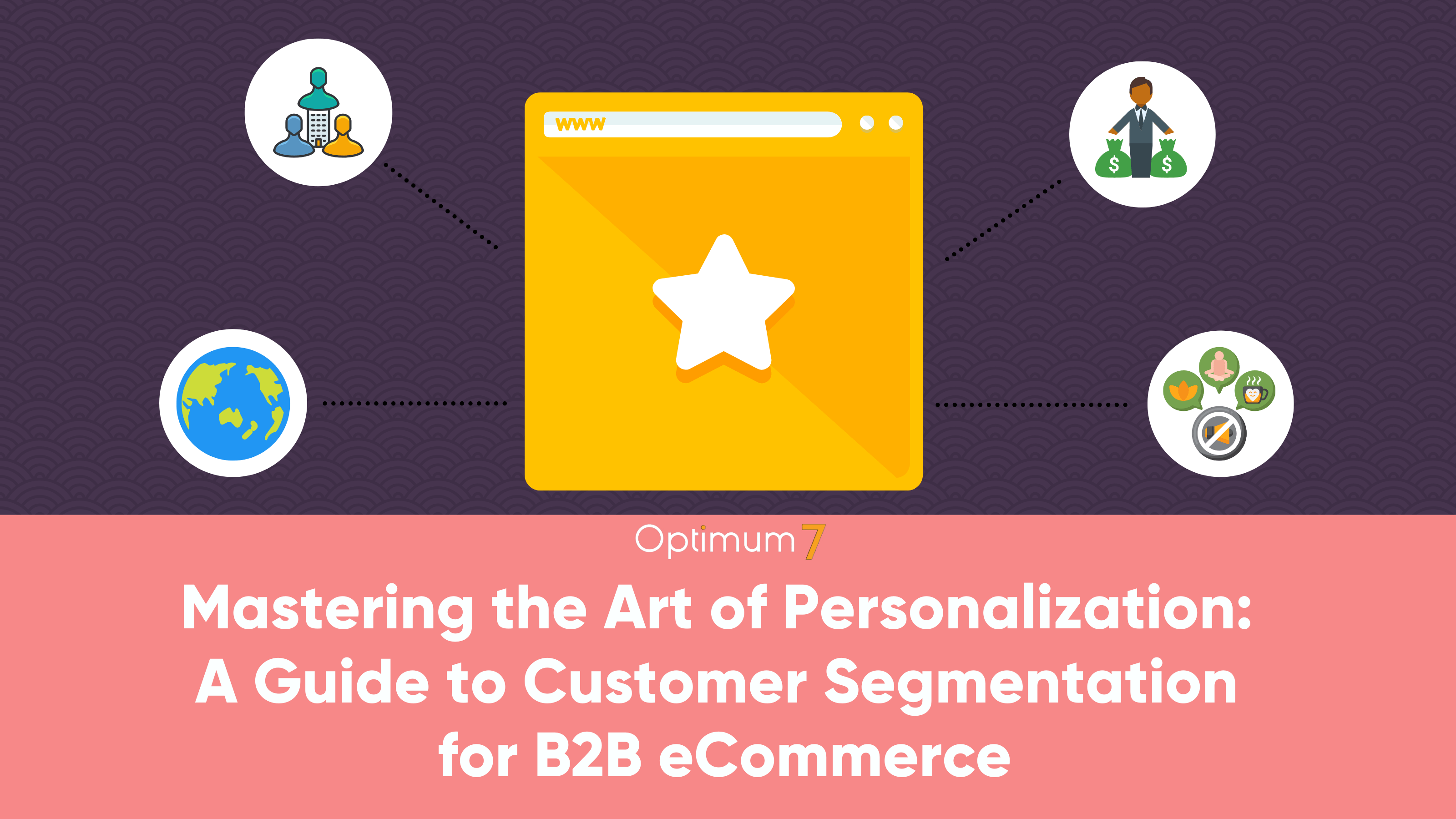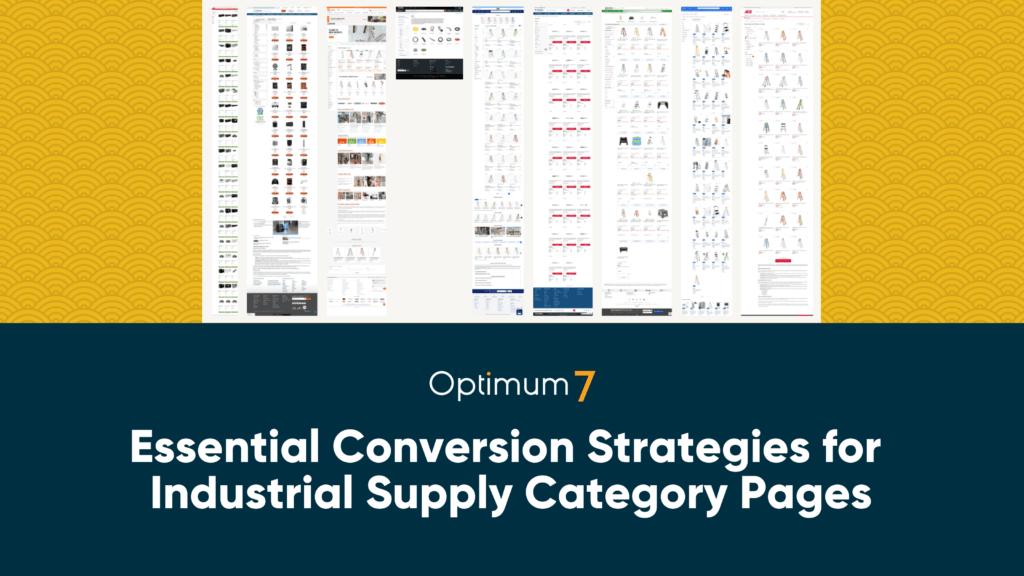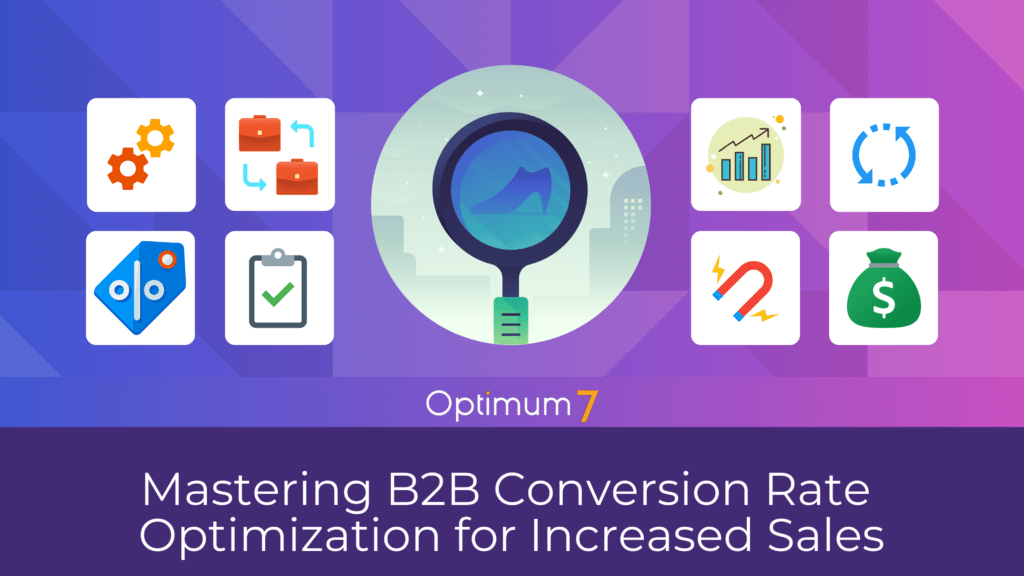Key Takeaways
- Customer segmentation, crucial in B2B eCommerce, allows for tailored marketing and improved customer satisfaction. The process involves data collection, analysis, persona creation, and technology utilization.
- Advanced technologies like AI and machine learning are revolutionizing customer segmentation, facilitating predictive analytics and constant refinement. Optimum7’s expertise and solutions are ready to guide businesses through this evolving landscape.
Navigating the complex B2B eCommerce marketing landscape can be daunting, especially when the average buying cycle involves around 35 touchpoints. Are your marketing efforts effectively engaging with each of these touchpoints? Or are you finding it a challenge to connect personally with your diverse clientele? The solution lies in an innovative approach that’s transforming eCommerce: customer segmentation.
Customer segmentation is not just a tool, but a game-changer for your B2B eCommerce store. It allows you to craft precise marketing strategies, enabling remarkable personalization and effective remarketing. By identifying and understanding your distinct customer groups, you can tailor your messaging and services to fit their unique needs like a glove.
Welcome to a world where your marketing hits the bullseye every time. With Optimum7 guiding you through customer segmentation, step into a future of enhanced customer relationships and elevated B2B eCommerce success.
Understanding Customer Segmentation
Ever tried shooting arrows in the dark? That’s what marketing can feel like without customer segmentation. It’s like trying to hit a target without knowing exactly where it is. Customer segmentation, at its core, is the process of dividing your customer base into distinct groups based on common characteristics.
These characteristics can range from age, location, buying habits, company size, to industry (in a B2B context) and more. The goal is to identify patterns of behavior or preferences that can inform your marketing, sales, and service strategies. In other words, customer segmentation is the process of turning the lights on, revealing your target clearly.
The importance of customer segmentation for any eCommerce business cannot be overstated. By understanding who your customers are, you can tailor your products, marketing messages, and overall experience to meet their unique needs and preferences. This personalization, in turn, drives customer satisfaction and loyalty, resulting in higher customer lifetime value.
This strategy is even more critical for B2B eCommerce businesses. The stakes are higher, the sales cycles are longer, and the buying process is more complex compared to B2C. By segmenting your customer base, you can identify key decision-makers, understand their needs, and tailor your approach accordingly, making your marketing and sales efforts more effective.
Now that you have an understanding of what customer segmentation is and why it is crucial for B2B eCommerce, let’s delve into the different types of customer segmentation and how you can implement it in your business.
The Role of Customer Segmentation in B2B eCommerce
Customer segmentation’s role in B2B eCommerce is as crucial as a compass to a ship navigating through uncharted waters. It not only points your business in the right direction but also helps you avoid pitfalls and capitalize on opportunities.
Let’s start by acknowledging a fundamental truth: B2B customers are significantly different from B2C consumers. B2B buyers are often teams or committees with unique buying procedures, longer sales cycles, and larger ticket sizes. Furthermore, the decision-making process is driven by logic and ROI rather than impulse or emotion.
That’s where customer segmentation comes into play. It allows for a deep understanding of these complex dynamics, helping businesses to personalize and tailor their strategies effectively. By segmenting customers based on their needs, behaviors, or firmographic attributes, B2B eCommerce businesses can focus their resources and efforts on the most profitable segments.
Consider a simple example: a business selling enterprise software might segment its customers by industry, company size, or specific pain points. Understanding these segments can help the business develop tailored marketing messages, create industry-specific software versions, or even predict future needs of its customers.
This level of customization can be the difference between winning or losing a contract in B2B eCommerce. Therefore, effectively implementing customer segmentation isn’t just a nice-to-have; it’s a crucial part of success.
Types of Customer Segmentation for eCommerce
Broadly speaking, there are several ways to segment your customers. Here’s a brief overview:
Demographic Segmentation
This involves grouping customers based on demographic factors such as age, gender, income, or educational level. While this type of segmentation is more common in B2C, it can still be useful in B2B, especially when coupled with other types.
Geographic Segmentation
This involves grouping customers based on their geographical location. This can be as broad as country or as specific as city or neighborhood. For B2B eCommerce businesses, geographic segmentation can help tailor offerings based on local regulations, culture, or economic conditions.
Behavioral Segmentation
This involves grouping customers based on their behaviors, such as their buying patterns, product usage, or loyalty. In B2B eCommerce, this can be instrumental in identifying high-value customers or understanding the effectiveness of marketing efforts.
Psychographic Segmentation
This involves grouping customers based on their attitudes, interests, or lifestyles. While less common in B2B, psychographic segmentation can still provide valuable insights, especially for businesses selling to small businesses or entrepreneurs.
Firmographic Segmentation
This involves grouping customers based on their company-specific characteristics such as industry, company size, or number of employees. Firmographic segmentation is specific to B2B and is often the cornerstone of B2B eCommerce customer segmentation.
In the next section, we’ll discuss how you can implement customer segmentation in your B2B eCommerce business. We’ll explore practical steps and key considerations to help you get started on this exciting journey.
Steps to Implement Customer Segmentation in B2B eCommerce
Taking your first steps into customer segmentation might seem daunting, but it needn’t be. Here’s a roadmap to help you get started:
1. Collecting Customer Data
The first step in customer segmentation is collecting customer data. The good news? You probably already have a wealth of data at your fingertips. Transaction records, customer interactions, feedback, website analytics—all these can provide valuable insights about your customers. External data, such as industry reports or social media behavior, can supplement your internal data.
In B2B eCommerce, important data points can include industry, company size, job roles, purchase history, website behavior, and customer feedback. Collecting this data can be as simple as using website analytics tools, customer surveys, or integrating a Customer Relationship Management (CRM) system.
2. Analyzing and Interpreting the Data
Once you’ve collected the data, it’s time to analyze it and look for patterns or trends. You might find that customers from a particular industry prefer a certain product, or companies of a certain size have similar buying behaviors. Using advanced data analytics tools can make this step easier and more effective.
3. Creating Customer Personas
Based on your analysis, you can start creating customer personas. These are detailed representations of different customer segments. A persona might include details about the customer’s industry, job role, key challenges, buying behaviors, and preferences.
For example, one persona might be “small tech startups looking for affordable software solutions,” while another could be “large corporations seeking advanced, customizable software solutions.” Each persona should represent a distinct customer group with unique needs and behaviors.
4. Implementing Segmentation Strategies
With your customer personas in hand, you can now start tailoring your strategies to each segment. This might involve creating personalized marketing messages, developing tailored products or services, or designing a unique customer journey for each persona.
For instance, if you find that your “small tech startup” persona is price-sensitive and prefers online support, you could offer competitive pricing and invest in self-service resources like a knowledge base or chatbot.
5. Role of Technology in Customer Segmentation
In the digital age, technology plays an essential role in customer segmentation. Tools such as CRM systems, data analytics platforms, and marketing automation software can help collect, analyze, and act on customer segmentation data.
For instance, Optimum7 offers solutions that help businesses streamline their customer segmentation efforts. These tools can automate data collection, provide deep insights, and enable personalized marketing at scale.
Finally, remember that customer segmentation is not a one-time task—it’s an ongoing process. Your customer base will evolve, and so should your segmentation strategy. Regularly review and update your segments to ensure they accurately represent your customers and their needs.
Challenges and Solutions in Customer Segmentation
As you embark on your customer segmentation journey, it’s essential to be aware of potential challenges. These can include data privacy concerns, the need for advanced analytics skills, or the challenge of acting on segmentation insights.
Thankfully, there are solutions for these challenges. Data privacy can be addressed by following best practices and regulations, advanced analytics can be outsourced or automated with tools, and implementing segmentation strategies can be facilitated with proper planning and the right technology.
Optimum7 is here to help businesses navigate these challenges. With a wealth of experience and a suite of advanced solutions, we can support your customer segmentation efforts, enabling you to reap the benefits while minimizing the challenges.
The Future of Customer Segmentation in eCommerce
As we look ahead, customer segmentation will only grow in importance. Advancements in artificial intelligence and machine learning are transforming how businesses collect, analyze, and act on customer data.
Predictive analytics can forecast future behavior based on past data, while machine learning can continually refine customer segments as new data comes in. These technologies enable even more personalized, timely, and effective marketing.
In this fast-evolving landscape, Optimum7 is committed to keeping businesses at the forefront of customer segmentation. With our advanced solutions and expert support, we can help you navigate the future of B2B eCommerce with confidence.
So, are you ready to harness the power of customer segmentation and take your B2B eCommerce business to the next level? Start your journey with Optimum7 today and learn how we can help segment your customer base through custom B2B eCommerce functionalities.






